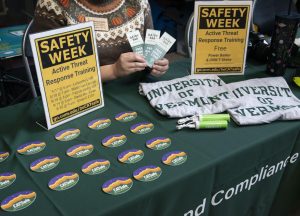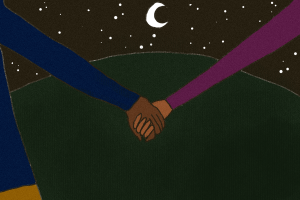Day 2: Student racial justice protesters take over Admitted Students Day
February 23, 2018
NoNames for Justice disrupted Admitted Students Day at UVM by staging a racial justice protest in the Davis Center.
A group of more than 200 protesters gathered for a second day of anti-administration protests on the fourth floor of the Davis Center. The protest, originally focused on informing prospective students, then moved to the Waterman building.
“If you are a person of color, if you so happen to be queer, if you so happen be an identity who is marginalized, then you’re going to have a tough time when you’re here [at UVM],” said sophomore Harmony Edosomwan, president of the Black Student Union.
“The reason that we’re doing this is to pave the way so that when you get here it’s a better place.”
10:00 a.m. Meeting with President Sullivan and Protest Leaders
Student leaders were offered a meeting with President Sullivan at 10 a.m., University Communications Director Enrique Corredera said.
“A small group of students did show up to that meeting and had a long conversation,” Corredera said.
Other students refused to have the meeting at 10 a.m., and said they would see Sullivan at 11 a.m. in the Davis Center, Edosomwan said.
11:00 a.m. Protests Begin
At the Feb. 22 protest on Main Street, protest leader and president of the Womyn of Color Coalition senior Angie Crespo told the crowd to continue the protest at the Davis Center the next morning.
The group gathered Friday, Feb. 23. Edosomwan addressed a crowd of admitted students and their families during Admitted Student Visit Day.
They met in the atrium of the Davis Center at 11 a.m. before moving to occupy fourth floor in the middle of an admitted student information fair.
Edosomwan said UVM was not as accepting and diverse as it advertises.
“My advice to admitted students is: don’t believe when the University says that it’s a progressive campus because I believed that,” she said. “And I was kind of woke back then, but I still believed that crap.”
John Mejia, a UVM employee who staged a week-long hunger strike that ended Feb. 23, addressed the crowd.
Mejia said the University was built on a foundation of white supremacy, cis-heteronormativity and male supremacy.
“We cannot make any real progress towards reconciliation without first acknowledging this history, and then taking action to build a new community around respecting the rights of all beings,” Mejia said.
Mejia then announced the end of their hunger strike.
“The point has been missed by those I have been trying to influence and it has harmed those that I love,” Mejia said. “Instead, I am going to refuel, recharge and work with all of you to make this institution the institution they say they want to see.”
Crespo encouraged protesters to take over the hashtag “#UVMsaidyes,” a tag used by admitted students. She told protesters to tweet “#UVMsaidyes to racism.”
“Remember, UVM said yes to you, but they said yes to a whole lot of other fucked-up shit, too,” Edosomwan said.
Admitted student Jamie Griffith, who watched the rally in the Davis Center, said he was impressed to see a student-organized protest.
“I guess it brings up questions of what racial equity is like on campus if this is an issue that does need to be addressed,” Griffith said. “But this is an issue that does need to be addressed globally, so it’s good that there is a culture of activism.”
12:18 p.m. Protesters move to Waterman
Protesters left the Davis Center and headed to President Tom Sullivan’s office in the Waterman building. Crespo said it was because Sullivan did not meet them downtown or in the Davis Center.
They moved to occupy the area outside the executive offices of Waterman.
The group chanted: “Hey hey, ho ho, Tom Sullivan has got to go” and “unblock the door” while banging on the executive office door.
Edosomwan read out Sullivan’s office phone number to the protesters and encouraged them to call him to come out to talk to the crowd.
“I don’t want to hurt Tom. I’m not going to go to jail for Tom. I’ve already sacrificed so much because of Tom — I’m not going to go to jail too,” Edosomwan said as the protesters tried to get the executive offices to open their doors.
1:32 p.m. Chair of BOT addresses protesters
David Daigle, chair of the board of trustees, stood in front of the protesters. Students offered him a Black Lives Matter sign, which he did not take.
“I’m not part of any movement,” Daigle said. “I will say, all of you are passionate and I think that’s great. But I also ask you on behalf of the entire community to make your advocacy respectful.”
Daigle said that he thinks that the only way progress will be made is if students and administration work together.
“Our common goals are the same: equality, justice, racial equality, inclusiveness — which is a really important one — and that’s one that we all collectively need to think about,” he said.
1:45 p.m. Tom Sullivan addresses protesters
Gary Derr, vice president of executive operations, and Sullivan walked out of the executive offices doors to address protesters. After nearly two hours of chanting, the students quieted.
Tom Sullivan addressed student protesters for the first time since Tuesday, when protests began.
“I feel that same urgency and I sometimes have the same frustrations,” Sullivan said. “Why do things take so long in our University community?”
He said both he and the rest of the administration are committed to successfully addressing University-wide issues, Sullivan said.
Edosomwan said that the protesters’ main demand was for Sullivan to rename the Bailey-Howe Library.
Guy Bailey was the president of UVM from 1919 to 1940, during which he served on the eugenics survey advisory committee, helping it to become the first privately funded survey at UVM, according to the eugenics survey history page on UVM’s website.
“We have proof that Bailey/Howe was on the eugenics board and he funded them,” she said.
David Howe was the publisher of the Burlington Free Press and founder of two local radio stations, WJOY and WOKO, according to UVM’s history website.
“So what we’re asking that you have the power to do — and so does David Daigle — we’re asking that you change the name of Bailey-Howe.”.
Daigle said there should be a process where someone can petition to rename a building and if anyone disagrees, they can make that case.
“What we ask for is that you not only have faculty on the [historical review] board,” Edosomwan said. “We don’t want administration on that board because lowkey we can’t trust y’all right now,” Edosomwan said.
Students waited outside for three hours for administration and nobody came, she said.
“I personally think that’s not a respectful conversation,” Daigle said. He and Sullivan then left the protesters and returned to their office.
Edosomwan said Derr has influence with students on campus because he is well-liked.
“You should say you support us, and that you’ll do everything in your power to make sure our demands are met and stand with us,” she said.
Derr said he was willing to work with students.
“I’m happy to come to the table and work with you along with my colleagues on these issues, and I would be happy to join that if that’s what would help,” he said. “I think the dialogue needs to continue.
“I think that right now this isn’t a constructive way to have the conversation.”
The protests are meant to make the administration uncomfortable because the administration continuously promises to make changes, Crespo said.
“This is not a personal attack. This is an attack on white supremacy, on white privilege,” she said.
2:13 p.m.
Students gave Sullivan a deadline of 2:30 p.m. to return to meet with them or they would escalate the protest.
“[We are] giving you until 2:30, or we’re gonna escalate even further,” Edosomwan said.
Several protest leaders, including Edosomwan, spoke privately with police and Annie Stevens, vice provost for student affairs.
“I wish we could come to some sort of resolution,” Stevens said.
2:30 p.m.
After a no-show from Sullivan, protesters announced a plan to walk out of classes at 1 p.m. Monday, Feb. 26.
4:59 p.m.
The University sent out an email addressing the day’s protests.
The email acknowledged the request for resignation of University officials and the end of Mejia’s hunger strike.
It included statements of support for administrations from both the Faculty Senate and school and all college deans.
“The UVM Faculty Senate Executive Council expresses its full and unwavering support for President Tom Sullivan, Provost David Rosowsky and Vice Provost Annie Stevens,” the senate stated.








